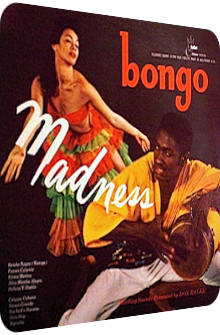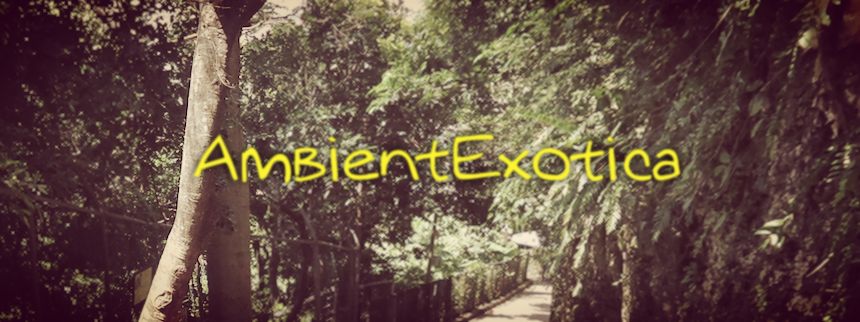
Don Ralke Presents
Bongo Madness
1957
When the Exotica genre was established in 1957, there was a simultaneous movement quite similar to the faux-Polynesian jungles full of beautiful women that were depicted on the front artwork and in many of the songs off those LP’s. I’m talking about a Jazz movement that was influenced by supposedly African rhythms, Latin tone sequences and, of course, bongos. Both movements are therefore very compatible to each other, for you find any of these particularities in Exotica songs as well. Bongo Madness, released in 1957 on the notorious Crown label, is one of these junctions through which the various styles and flavors akin to Afro Jazz, tropical Exotica and hot-blooded Latin music flow. Even though this ten-track album is easily available in various forms due to its re-release in 2006, there are many myths, nonconformances and wrong interpretations in terms of the artists involved, many of which I’m trying to clarify below.
It’s decades too late for complaining and pointing out the mistakes, but as usual, the Crown-related re-release tactics are as extraordinary as the original release of Bongo Madness. Four things jump to my mind immediately when I’m thinking about this record: firstly, bongo afficionado and pianist Don Ralke is indeed involved in the album with both unique compositions and by playing the piano, but he is not the sole artist or creator of it. Instead, his function is that of a presenter, a guy whose good taste you can trust when it comes to bongo music.
The album is actually the collaborative effort of a quintet: Buddy Collette is playing the flute, Jack Burger hits the drums, Tom Wofford does the same with the congas, Don Tosti is on the bass and Don Ralke, as stated before, plays the piano and comes up with three unique compositions that are complemented with one conception by Tosti, another one by Burger as well as several traditional pieces. Secondly, throughout the liner notes, the name of the presenter is written as Don Ralké. I don’t know what to make of this. It is possibly an early coolness indicator – you know, like the already outdated distinction between a party and a partay – or just a curious typo. Thirdly, I have to bring the re-issue tactics of Crown to the agenda yet again. As usual, their re-issue tactics cause fear, uncertainty and doubt among Exotica fans, but especially among interested listeners who are willed to pay for a digital download but don’t know where to start.
All of us have been at this point, and I’m sure the following flaws wouldn’t help us: Crown Records, living up to their notoriety, changed the song titles of the original release and their running order in the 2006 re-issue. To give one example: track 9 on the original, called Afro-Bop, is now track 2 on the re-issue and called Azul. Why? Because these people can! But, lastly, there’s one more thing which I cannot believe: Bongo Madness is re-released under three different names, one time under its real name and secondly in two further editions called More Bongo Madness and Even More Bongo Madness. However, despite their different artwork, they’re all the same! Imagine a listener buys Bongo Madness, likes what he or she hears and is happy to find out that More Bongo Madness and Even More Bongo Madness are also available. The Buy button is swiftly clicked, and away the listener goes with yet another version of the same album for additional money. I’ll let you be the judge on these tactics. Enough of these bad vibes, let’s check out the surprisingly multifaceted songs off the original release.
Bembe Negro starts the album with an exhilarative flute melody and a muffled conga beat. This track is unique in that the drums are beaten in 6/8 time, thus merging the two distinctive elements – the blithesome flute and a tribal beat – into an interestingly bright song that is yet baneful in its appearance. The Exotica flavor is high because these instruments are found time and again in the genre, and the upbeat presentation should please anyone who fears that this album moves too boldly into the direction of the Afro Jazz genre. Pasion Calienta is a Don Ralke composition with an even more gleeful flute, jazzy double bass backings and punchy piano accompaniments. The best part, however, occurs in the second half of the song when a long bongo and conga solo is performed that is tremendously life-like but still laid back enough to not destroy the fluffy atmosphere of this light-hearted composition.
Ritmo Marteo is a gorgeous African lamento with Buddy Collette at his finest, delivering a long flute solo reminiscent to Tony Scott’s Music For Zen Mediation. It’s really that good and Far Eastern sounding. It is later turned into a teamplay with additional bongos, claves and snake-like rattles. The atmosphere thus completely shifts, and the quintet delivers the most serious performance on the album. In the second half of Ritmo Marteo the tempo is increased, the beats are hectic, but the sad flute melody remains. The short Afro Mambo Alegre moves into Cuban territory, quite exciting and strictly forbidden at the time of this release. Ralke’s Latin piano chords are glaring and rumbling, and even though they are purposefully rudimentary, they work perfectly well with the bongo-conga couplings and the jungle atmosphere these percussive instruments create.
The Don Tosti composition Bellezo Y Diablo ends side A on a mysteriously calamitous note with a percussive introduction that only features a spectral shadow of Collette’s flute which remains whisper quiet in the background for the first minute, all the while a terrifically portentous six-note double bass melody is slapped by Tosti that sends shivers down my spine and links back to the track title in the most formidable way. Even when the flute melody grows louder, its mystique remains, leaving the joyfulness of the first two song behind, creating a piece of caution and paranoia. On this song, Tosti is in the limelight, and his bass melody wouldn’t be out of place in the softer compositions of 80’s Metal.
Side B consists similarly manifold tracks. While Calypso Cubano could almost be a cheerful military march, as the bongo beat is very strict and the high notes of the flute are regularly answered by additional bongos, Sesion Grande is the most sophisticated percussive track with not even a glimpse of a melody. Several maracas, cow bells and claves join forces in order to build a tremendously tropical aura that is not too hectic rather than strolling along in a mid-tempo. I rate this song very highly, for there aren’t many Exotica pieces that focus solely on the percussion.
Noche In Havana is the penultimate composition by Ralke that is featured on Bongo Madness, and it may well be my favorite out of the three due to the colorful piano chords that burst like bubbles over a very soothing flute melody and an distant double bass line that goes slowly up and down. Overall, it is a terrific composition that aims at the softer side of Latin music. A terrific composition and one of the most underrated unique Exotica compositions that has never been picked up by other Exotica bands.
Afro-Bop is the final Ralke piece with a strong focus on the whole quintet, as everyone is involved one last time in this one: paradisiac flute melodies, a lucid conga groove, jazzy bass lines and reduced piano backings make this a very vivid, lively song that is given a counterpoint with the hyper-eclectic Mgombo, the second percussive track, but this time it consists of a freely flowing improvised solo by Burger. Rather than relying on song structures, Burger uses this performance as his business card and beats every drum he can find. I like Sesion Grande better due to its gentler rhythm and observable structure, but Mgombo is a feast for Exotica fans who are craving for percussion-only songs.
Bongo Madness is to this day a successful take on the then rising market of Afro Jazz or Cuban Jazz. However, it also blends exquisitely with the Exotica genre due to Collette’s effervescent flute melodies and the bold bongo and conga percussion that is used on all of the ten tracks. Don Ralke’s three compositions are specifically worth noting, my favorite being Noche In Havana due to its dreamy painting of a nocturnal peaceful landscape near the capitol. But Don Tosti’s Bellezo Y Diablo is equally outstanding due to its gloomy bass sequences that is foreshadowing an omnipresent calamity.
The variety itself is the selling point of this release, for you wouldn’t expect such a wide multifariousness due to the album not being marketed that way. I can thus recommend it wholeheartedly to bongo fans in particular and Exotica fans in general, as all of the above compositions aren’t featured prominently on other records, especially not the Ralke compositions, which is an utter shame. If you are puzzled about which of the three re-issued versions you should buy, I recommend you’d go with Even More Bongo Madness, as it contains the tracks in the right order. The track titles are also properly tagged with their correct names. Why it is necessary for Crown to re-issue their albums several times with ever-changing track titles – Milt Raskin’s Kapu and Alex Keack’s Surfers Paradise come to mind – is beyond me, but don’t let these peculiarities spoil the fun. Bongo Madness is chock-full of melodies and bongos, and the sound quality is good as well.
Ambient Review 067: Don Ralke Presents – Bongo Madness (1957). Originally published on May 5, 2012 at AmbientExotica.com.
